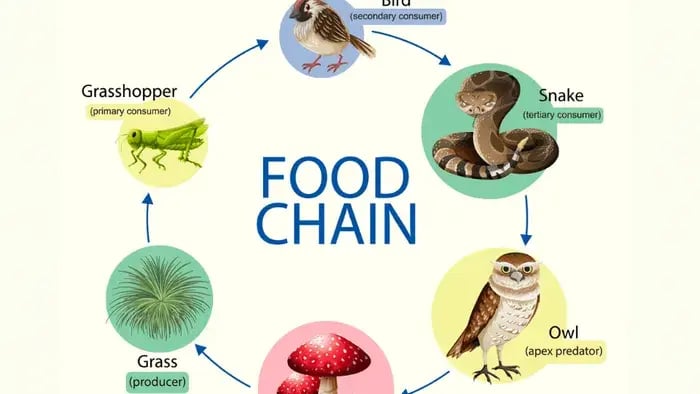- Interdependence of Nature
- Ecosystem Balance
- Real-World Knowledge
- Environmental Awareness
- Forest Food Chain
- Desert Food Chain
- Ocean Food Chain
- Food Chain at Home
Introduction
The food chain refers to the systematic flow of energy in the environment that depicts the transfer of nutrients from one organism to the other through consumption. The world that we live in consists of various elements. Each of these elements is in a symbiotic relation where they support each other's existence. Hence, the food chain is one of the primary level concepts that kids learn before dwelling on deep biological and ecological studies. Understanding the ecological interdependence among organisms allows the child to foster a deeper appreciation towards all living beings. The linear sequence of transfer of food from one source to the other may also help a kid understand how a producer in one scenario can be a consumer in another scenario. Learning of the food chain can be facilitated by engaging kids in activities such as drawing, making them watch relevant visuals, taking them to local parks and different terrains to see live examples, and so much more.
Importance of Teaching Food Chain to Kids
Here are some of the top reasons why you should be teaching the food chain to your kids.
-
Interdependence of Nature
Nature is made up of various elements, including plants and different types of organisms, all of which are interdependent upon each other for their survival. Teaching kids' food chains helps them understand how directly and indirectly plants are dependent upon organisms and organisms are dependent on plants for survival.
-
Ecosystem Balance
The balance between producers and consumers in nature is important to ensure the world functions without any unwanted disruption. Teaching this to kids helps them understand why it is important for an animal to hunt other animals in the forest and how it helps in attaining an ecological balance.
-
Real-World Knowledge
Understanding balance and the theory of production and consumption helps the child understand a lot of real-world problems as well. A deep sense of understanding of the food chain can make their real-life interactions and learning easier.
-
Environmental Awareness
By making the child aware of the different elements in nature and the importance of each of them, parents can make them more responsible towards their environment.
Fun and Easy Examples to Explain Food Chain
Here is a list of some fun and easy-to-understand examples for kids to understand the food chain.
-
Forest Food Chain

Tree (producer)-> caterpillar (eats the leaves from the tree)-> birds (eats the caterpillar)-> hawk (eats birds)
This is an easy and very practical and easily understandable example of a food chain that can be explained to the child. For better understanding, you may also take your child to a nearby park to show them the caterpillar eating the leaves from the tree. Simultaneously, you may also show the child how birds hunt caterpillars as a source of food. The child will be easily able to join the dots and get the gist of the concept.
-
Desert Food Chain
Cactus(producer)-> insects (eat cactus) -> lizard (eats insects) -> snake (eats lizard)-> Hawk (eat snake)
Explaining the desert- food chain can be supported by a video showcasing each of these elements coming in contact with each other to complete the chain. Seeing the elements interact with each other will also give the child a better clarity about how a desert food chain is different and, in many ways, also similar to other food chain examples.
-
Ocean Food Chain

Algae (producer)-> small fish (eats algae)-> big fish (eats small fish)
The ocean is full of a lot of fascinating elements that can make the child's learning more interesting and fun. To make the learning more experiential, you may take your child to the nearest aquarium to showcase to them how the ocean food chain works. Seeing the underwater animals interact in their ecosystem will not only amaze your child but will also interest them to look further and explore more.
-
Food Chain at Home
Apple (producer)-> worm (eats apple) -> birds (eats worm)
If you want to explain to your child how the food chain works through a more practical and accessible source, then you can also create one at your home. Simply put an apple in your garden or open area. In some time, you will see that worms or ants accumulate near the Apple to eat it. These worms will then be attacked by the birds in your garden. However, during this whole process, you will have to stay vigilant with your child to experience everything all at once.
Conclusion

Making your child understand how the circle of life works can make them feel more connected to the real world. The basic level of understanding can be initiated through dinner table conversations eventually explaining complex food cycles. All of this not only enhances a kid's understanding of the concept but also helps in developing a scientific temper among children.
Pakhi’s deep interest in writing is influenced by her love for cinema and fiction books. Being a literature graduate, she is relentlessly inspired by different storytelling techniques to craft her work and bring a fresh perspective to the table. Having studied psychology, she also loves to explore various psychological insights related to kids’ and parents’ behavior to create engaging content pieces. Apart from that, she enjoys jamming to some great R&B music in her leisure time.
The views expressed are that of the expert alone.
The information provided in this content is for informational purposes only and should not be considered a substitute for professional medical advice, diagnosis, or treatment. Always seek the advice of your physician or another qualified healthcare provider before making any significant changes to your diet, exercise, or medication routines.
References
https://education.nationalgeographic.org/resource/food-chain/
https://www.researchgate.net/publication/384600043_Food_chainPerception_Evaluation_-A_Review










